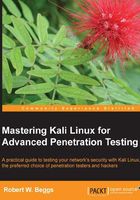
Chapter 3. Active Reconnaissance and Vulnerability Scanning
The objective of the reconnaissance phase is to gather as much information about the target as possible in order to facilitate the exploitation phase of the kill chain.
We have seen how passive reconnaissance, which is almost undetectable, can yield a significant amount of information about the target organization and its users.
Active reconnaissance builds on the results of open-source intelligence and passive reconnaissance, and focuses on using probes to identify the path to the target and the exposed attack surface of the target. In general, complex systems have a greater attack surface, and each surface may be exploited and then leveraged to support additional attacks.
Although active reconnaissance produces more information, and more useful information, interactions with the target system may be logged, triggering alarms by protective devices, such as firewalls and intrusion detection systems. As the usefulness of the data to the attacker increases, so does the risk of detection; this is shown in the following diagram:

To improve the effectiveness of active reconnaissance in providing detailed information, our focus will be on using stealthy, or difficult to detect, techniques.
In this chapter, you will learn:
- Stealth scanning strategies
- Network infrastructure, host discovery, and enumeration
- Comprehensive reconnaissance applications, especially
recon-ng - Targeted vulnerability scanning